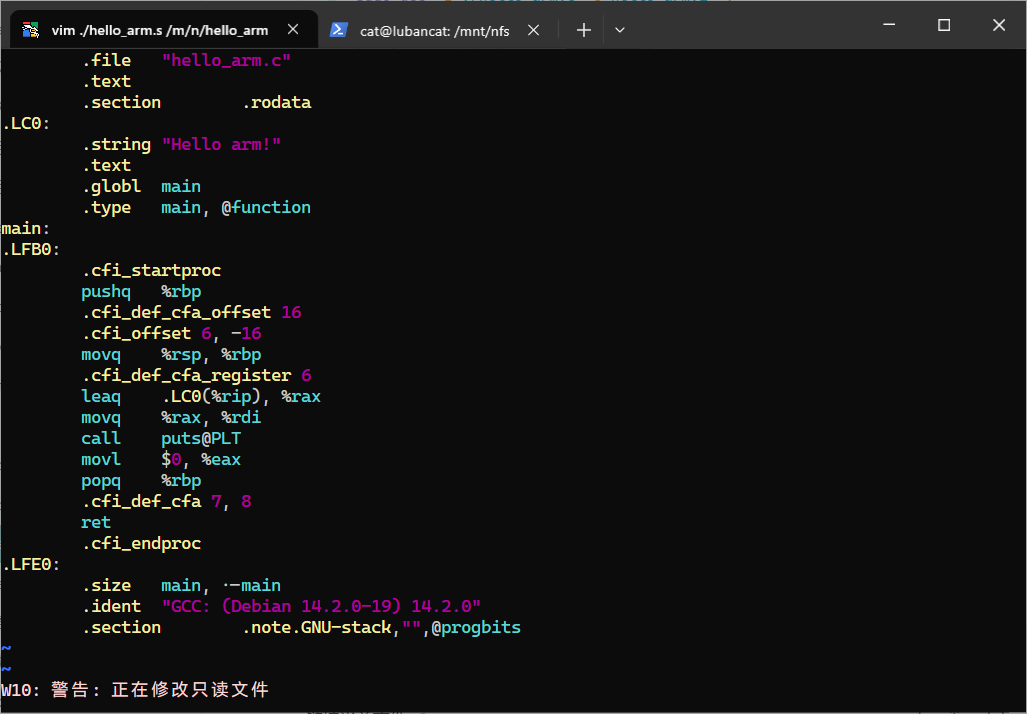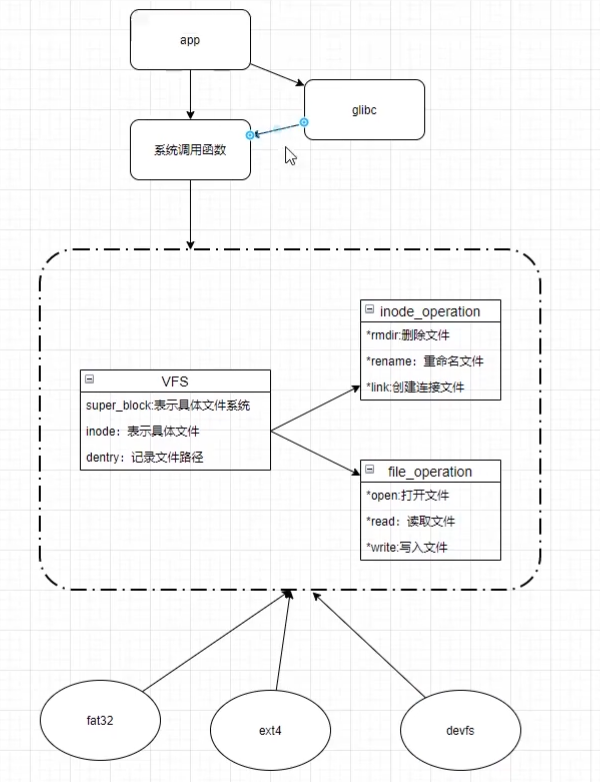gcc预处理c文件
sudo gcc -E ./hello_arm.c -o hello_arm.i -v
/usr/libexec/gcc/x86_64-linux-gnu/14/cc1
-E -quiet -v -imultiarch x86_64-linux-gnu ./hello_arm.c -o hello_arm.i
-mtune=generic -march=x86-64 -fasynchronous-unwind-tables -dumpbase hello_arm.c -dumpba*gcc 编译c文件
sudo gcc -S hello_arm.i -o hello_arm.s -v
/usr/libexec/gcc/x86_64-linux-gnu/14/cc1 -fpreprocessed hello_arm.i -quiet -dumpbase hello_arm.i -dumpbase-ext .i -mtune=generic -march=x86-64 -version -o hello_arm.s -fasynchronous-unwind-tables注意:这里是大写S 如果输入小写s就相当于编译了一个可执行文件了 编译后的汇编文件输出 
gcc编译汇编
gcc -c hello_arm.s -o hello_arm.o -v
as -v --64 -o hello_arm.o hello_arm.sgcc链接可重定位文件
gcc hello_arm.o -o hello_arm -v
/usr/libexec/gcc/x86_64-linux-gnu/14/collect2 -plugin /usr/libexec/gcc/x86_64-linux-gnu/14/liblto_plugin.so -plugin-opt=/usr/libexec/gcc/x86_64-linux-gnu/14/lto-wrapper -plugin-opt=-fresolution=/tmp/ccu8Dzjz.res -plugin-opt=-pass-through=-lgcc -plugin-opt=-pass-through=-lgcc_s -plugin-opt=-pass-through=-lc -plugin-opt=-pass-through=-lgcc -plugin-opt=-pass-through=-lgcc_s --build-id --eh-frame-hdr -m elf_x86_64 --hash-style=gnu --as-needed -dynamic-linker /lib64/ld-linux-x86-64.so.2 -pie -o hello_arm /usr/lib/gcc/x86_64-linux-gnu/14/../../../x86_64-linux-gnu/Scrt1.o /usr/lib/gcc/x86_64-linux-gnu/14/../../../x86_64-linux-gnu/crti.o /usr/lib/gcc/x86_64-linux-gnu/14/crtbeginS.o -L/usr/lib/gcc/x86_64-linux-gnu/14 -L/usr/lib/gcc/x86_64-linux-gnu/14/../../../x86_64-linux-gnu -L/usr/lib/gcc/x86_64-linux-gnu/14/../../../../lib -L/lib/x86_64-linux-gnu -L/lib/../lib -L/usr/lib/x86_64-linux-gnu -L/usr/lib/../lib -L/usr/lib/gcc/x86_64-linux-gnu/14/../../.. hello_arm.o -lgcc --push-state --as-needed -lgcc_s --pop-state -lc -lgcc --push-state --as-needed -lgcc_s --pop-state /usr/lib/gcc/x86_64-linux-gnu/14/crtendS.o /usr/lib/gcc/x86_64-linux-gnu/14/../../../x86_64-linux-gnu/crtn.ocollect2 封装了ld链接器(ld就是gcc的标准链接器) -dynamic-linker 表明动态编译(默认)
如果启用动态(使用 -static参数)
gcc hello_arm.o -o hello_arm -v -static
/usr/libexec/gcc/x86_64-linux-gnu/14/collect2 -plugin /usr/libexec/gcc/x86_64-linux-gnu/14/liblto_plugin.so -plugin-opt=/usr/libexec/gcc/x86_64-linux-gnu/14/lto-wrapper -plugin-opt=-fresolution=/tmp/ccyTPuMR.res -plugin-opt=-pass-through=-lgcc -plugin-opt=-pass-through=-lgcc_eh -plugin-opt=-pass-through=-lc --build-id -m elf_x86_64 --hash-style=gnu --as-needed -static -o hello_arm /usr/lib/gcc/x86_64-linux-gnu/14/../../../x86_64-linux-gnu/crt1.o /usr/lib/gcc/x86_64-linux-gnu/14/../../../x86_64-linux-gnu/crti.o /usr/lib/gcc/x86_64-linux-gnu/14/crtbeginT.o -L/usr/lib/gcc/x86_64-linux-gnu/14 -L/usr/lib/gcc/x86_64-linux-gnu/14/../../../x86_64-linux-gnu -L/usr/lib/gcc/x86_64-linux-gnu/14/../../../../lib -L/lib/x86_64-linux-gnu -L/lib/../lib -L/usr/lib/x86_64-linux-gnu -L/usr/lib/../lib -L/usr/lib/gcc/x86_64-linux-gnu/14/../../.. hello_arm.o --start-group -lgcc -lgcc_eh -lc --end-group /usr/lib/gcc/x86_64-linux-gnu/14/crtend.o /usr/lib/gcc/x86_64-linux-gnu/14/../../../x86_64-linux-gnu/crtn.o静态编译与动态编译比较
静态  静态态
静态态 

可见 静态编译耗时更久,且生成文件体积更大
Makefile
如何学习Makefile
Makefile的本质: 无论多么复杂的的语法,都是为了更好的解决项目文件之间的依赖关系。
三要素
目标、依赖、命令 目标:依赖的文件或其它目标 <tab>命令1 <tab>命令2 <tab>命令...
vim Makefile
targeta:targetb targetc
echo "targeta"
targetb:
echo "targetb"
targetc:
echo "targetc"
保存退出执行:
make
输出:
echo "targetb"
targetb
echo "targetc"
targetc
echo "targeta"
targeta通过.PHONY: 可以指定伪目标,不需要目标文件存在,而直接执行目标对应的命令
变量
系统变量
$(CC) $(AS) $(MAKE)
自定义变量
= , 延时赋值 直到引用这个变量时才会赋值 := , 立即赋值 普通含义的赋值 ?= , 空赋值 变量为空赋值才有效 +=,追加赋值 在原值后加入新的值
自动化变量
$< , 第一个依赖文件 $^ , 全部的依赖文件 $@ , 目标
模式匹配
%: 匹配任意多个非空字符 shell: * 通配符
.o后缀的目标文件依赖同名的.c文件 使用CC变量,即gcc,编译,$<第一个依赖 $@目标
%.o:%.c
$(CC) -c $< -o $@默认规则
.o文件默认使用.c文件编译
条件分支
ARCH ?= x86
ifeq ($(ARCH),x86)
CC=gcc
else
CC=aarch64-linux-gnu-gcc-12
endifLinux文件虚拟文件系统
一切皆文件
屏蔽硬件区别,所有硬件设备抽象成文件,提供统一接口 抽象层,对文件的访问实际是对抽象层的访问
- 抽象对象:封装了底层的读写细节,使用多态来实现具体的文件系统接口
普通文件系统
- ext4
- fat32
- ubifs
特殊文件系统
- 进程文件系统:procfs,挂载在/proc,存放进程相关信息,任务管理器
- 设备文件系统:devfs/,挂载在/dev.存放硬件操作接口

文件描述符和打开模式
系统io编程
- open
- write
- read
- lseek
- close
VFS->file_operation
int fd;
fd = open(filename, flags, mode);
lseek(fd,offset,whence);
write(fd,buf,write_len);
read(fd,buf,read_len);
close(fd);文件描述符
实际就是进程中file_struct结构体成员fd_array的数组下标
Linux系统文件操作(系统调用)
open_close
#include <sys/types.h>
#include <sys/stat.h>
#include <fcntl.h>
int open(const char *pathname, int flags); // 当文件操存在时
int open(const char *pathname, int flags, mode_t mode); // 当文件不存在时,指定文件权限返回值:
- 成功:文件描述符
- 失败:-1
文件打开模式
主模式:
- O_RDONLY:只读模式
- O_WRONLY:只写模式
- O_RDWR:读写模式 副模式:
- O_CREATE:当文件不存在,需要创建文件
- O_APPEND:追加模式
- O_DIRECT:直接IO模式
- O_SYNC:同步模式
- O_NoBLOCK:非阻塞模式
#include <unistd.h>
int close(int fd);返回:
- 成功:0
- 失败:-1
#include <stdio.h>
#include <sys/types.h>
#include <sys/stat.h>
#include <fcntl.h>
#include <unistd.h>
int main()
{
int fd;
fd = open("./b.txt", O_RDONLY|O_CREAT, 0666);
if (fd < 0) {
printf("open error!!\r\n");
}
printf("fd:%d\r\n",fd);
close(fd);
return 0;
}read_write函数的使用
read函数
#include <unistd.h>
ssize_t read(int fd, void *buf, size_t count);read函数用于从文件中读取若干个字节的数据,保存到数据缓冲区buf中,并返 回实际读取的字节数,具体函数参数如下:
- fd:文件对应的文件描述符,可以通过fopen函数获得。另外,当一个程序 运行时,Linux默认有0、1、2这三个已经打开的文件描述符,分别对应了标准输入、标准输出、标准错误输出,即可以直接访问这三种文件描述符;
- buf:指向数据缓冲区的指针;
- count:读取多少个字节的数据。 返回值:
- count: 成功读取全部
- 0-count:
- 剩余文件长度小于count
- 读取期间被异步信号打断
- -1: 失败
write函数
#include <unistd.h>
size_t write(int fd, const void *buf, size_t count);write函数用于往文件写入内容,并返回实际写入的字节长度,具体函数参数如下:
- fd:文件对应的文件描述符,可以通过fopen函数获得。
- buf:指向数据缓冲区的指针;
- count:往文件中写入多少个字节。 返回值:
- count: 成功写入全部
- 0-count:
- 写入期间被异步信号打断
- -1: 失败
lseek_sync
lseek函数可以用与设置文件指针的位置,并返回文件指针相对于文件头 的位置。其函数原型如下:
# include<unistd.h>
off_t lseek(int fd, off_t offset, int whence);它的用法与flseek一样,其中的offset参数用于指定位置,whence参数则定义了offset的意义,whence的可取值如下:
- SEEK_SET:offset是以文件开头为参考点。
- SEEK_END:offset是以文件尾为参考点的相对位置。
- SEEK_CUR:offset是以当前位置为参考点的相对位置。 返回:
- 成功:文件偏移值
- 失败:-1 sync:强制把修改后的页缓存区数据写入磁盘
#include <unistd.h>
void sync(void);返回:无
#include <sys/types.h>
#include <sys/stat.h>
#include <fcntl.h>
#include <unistd.h>
#include <stdio.h>
int main() {
int fd = open("file", O_RDWR|O_CREAT, 0666);
write(fd, "123", 3);
lseek(fd, 100, SEEK_CUR);
write(fd, "abc", 3);
sync();
close(fd);
return 0;
}IO文件标准库
标准库实际是对系统调用再次进行了封装。 使用C标准库编写的代码,能方便地在不同的系统上移植。
例如Windows系统打开文件操作的系统API为OpenFile,Linux则为open,C标准库都把它们封装为fopen,Windows下的C库会通过fopen调用OpenFile函数实现操作,而Linux下则通过glibc调用open打开文件。用户代码如果使用fopen,那么只要根据不同的系统重 新编译程序即可,而不需要修改对应的代码。
8.5.1.1. fopen函数
fopen库函数用于打开或创建文件,返回相应的文件流。它的函数原型如下:
#include <stdio.h>
FILE *fopen(const char *pathname, const char *mode)- pathname参数用于指定要打开或创建的文件名。
- mode参数用于指定文件的打开方式,注意该参数是一个字符串,输入时需要带双引号:
- “r”:以只读方式打开,文件指针位于文件的开头。
- “r+”:以读和写的方式打开,文件指针位于文件的开头。
- “w”:以写的方式打开,不管原文件是否有内容都把原内容清空掉,文件指针位于文件的开头。
- “w+”: 同上,不过当文件不存在时,前面的“w”模式会返回错误,而此处的“w+”则会创建新文件。
- “a”:以追加内容的方式打开,若文件不存在会创建新文件,文件指针位于文件的末尾。与“w+”的区别是它不会清空原文件的内容而是追加。
- “a+”:以读和追加的方式打开,其它同上。
- fopen的返回值是FILE类型的文件文件流,当它的值不为NULL时表示正常,后续的fread、fwrite等函数可通过文件流访问对应的文件。
8.5.1.2. fread函数
fread库函数用于从文件流中读取数据。它的函数原型如下:
#include <stdio.h>
size_t fread(void *ptr, size_t size, size_t nmemb, FILE *stream);stream是使用fopen打开的文件流,fread通过它指定要访问的文件,它从该文件中读取nmemb项 数据,每项的大小为size,读取到的数据会被存储在ptr指向的数组中。fread的返回值为成功读取的项数(项的单位为size)。
8.5.1.3. fwrite函数
fwrite库函数用于把数据写入到文件流。它的函数原型如下:
#include <stdio.h>
size_t fwrite(void *ptr, size_t size, size_t nmemb, FILE *stream
);它的操作与fread相反,把ptr数组中的内容写入到stream文件流,写入的项数为nmemb,每项 大小为size,返回值为成功写入的项数(项的单位为size)。
8.5.1.4. fclose函数
fclose库函数用于关闭指定的文件流,关闭时它会把尚未写到文件的内容都写出。因为标准 库会对数据进行缓冲,所以需要使用fclose来确保数据被写出。它的函数原型如下:
#include <unistd.h>
int close(int fd);8.5.1.5. fflush函数
fflush函数用于把尚未写到文件的内容立即写出。常用于确保前面操作的数据被写 入到磁盘上。fclose函数本身也包含了fflush的操作。fflush的函数原型如下:
#include <stdio.h>
int fflush(FILE *stream);8.5.1.6. fseek函数
fseek函数用于设置下一次读写函数操作的位置。它的函数原型如下:
#include <stdio.h>
int fseek(FILE *stream, long offset, int whence);其中的offset参数用于指定位置,whence参数则定义了offset的意义,whence的可取值如下:
- SEEK_SET:offset是一个绝对位置。
- SEEK_END:offset是以文件尾为参考点的相对位置。
- SEEK_CUR:offset是以当前位置为参考点的相对位置。
表 fopen的mode与open的flags参数关系
| fopen的mode参数 | open的flags参数 |
|---|---|
| r | O_RDONLY |
| w | O_WRONLY | O_CREAT | O_TRUNC |
| a | O_WRONLY | O_CREAT | O_APPEND |
| r+ | O_RDWR |
| w+ | O_RDWR | O_CREAT | O_TRUNC |
| a+ | O_RDWR | O_CREAT | O_APPEND |
- mode:当open函数的flag值设置为O_CREAT时,必须使用mode参数来设置文件 与用户相关的权限。mode可用的权限如下表所示,表中各个参数可使用“| ”来组 合。